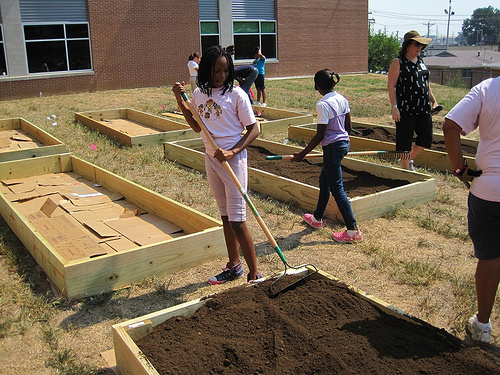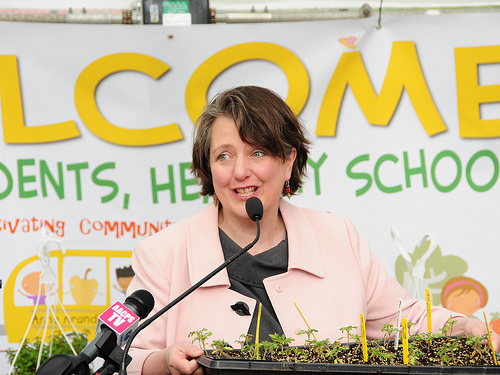An apple for the teacher? Yes, and the cafeteria too.
Classic images of eager children handing perfect apples to their teacher abound. In the idealized imagery, the apples are often shiny, red, and round. And if you are angling for a good grade, or really like your teacher, the apples are big. But in New Hampshire it was “school boy” apples, the small ones 2 – 3 inches in diameter, which launched an impressive farm to school program.
The New Hampshire Farm to School Program (NHFTS) was established in 2003 as a pilot program funded by the USDA’s Sustainable Agriculture Research & Education (SARE) program to introduce local apples and cider into New Hampshire K-12 schools.
“We really saw the small apples as an entry point for our farm to school program. Not many supermarkets or other vendors are interested in the smaller fruit, but they are the perfect size for schools,” said Elisabeth Farrell, Sustainability Program Manager of the Sustainability Institute at the University of New Hampshire. Read more »

Students at Barack Obama Elementary School, near St. Louis, learn about healthy food choices through gardening.
Acting Deputy Undersecretary for Rural Development Judith Canales recently had the opportunity to visit Missouri’s new Barack Obama Elementary School located in a suburb of St. Louis. The school district has started the Barack Obama Elementary Healthy Food Pilot Project where the objective is to serve a healthier school breakfast and lunch menu. As part of this pilot project, the Farm to School Program is being incorporated to bring in more locally grown produce. The elementary school has also created a school garden in partnership with community members, community-based organizations, and a local community gardening group. It appears that they are on the right track! Read more »
USDA’s Food and Nutrition Service (FNS) recently released its 2009-10 School Food Purchase Study, which provides national estimates of the quantity, value and unit price of food acquisitions by school districts participating in the National School Lunch and School Breakfast programs. This year, the Survey for the first time asked specifically if school districts were purchasing local food and included questions about the total value of purchases and the major items purchased.
School district responses provide an important baseline for tracking the national progress of local food purchases by school food service programs. The responses showed that about 2 out of every 10 school districts surveyed purchased local produce for school meals during the 2009-10 school year, based on responses from a nationally representative sample of 416 school district food service directors about practices for purchasing food for school meal programs. An additional 12 percent indicated that they are in the process of developing a program for buying locally grown produce. Read more »

First-hand experiences with agriculture are a key component of farm to school programs.
Webinar Offers More Details on USDA Grants to Connect Schools and Local Producers
I’ve always thought the Let’s Move! initiative does an exceptional job of including everyone in the challenge of creating a healthier generation of kids. On the agriculture side, I’m pleased to say there’s a long list of folks eager to contribute: farmers, ranchers, fishermen, dairies, food processors, manufacturers, distributors and many others. Read more »

USDA Deputy Secretary Kathleen Merrigan discovers “Abe Lincoln tomatoes” during her visit to Southern High School in Anne Arundel county, MD.
Cross posted from the Let’s Move! blog:
Last week USDA released a new farm to school grant program designed to help give children a sense of where their food comes from and increase the availability of local foods in schools. Joined by students at Southern High School in Harwood, MD, as well as school and elected officials, Deputy Secretary Kathleen Merrigan made the announcement in an on-campus greenhouse. Read more »
Cross posted from the White House blog:
Three years ago, I was asked to participate in the White House Task Force on Childhood Obesity, out of which grew the First Lady’s Let’s Move! initiative. In May 2010, we submitted a report to the President that made a series of recommendations for addressing the challenges of obesity and hunger, both of which stem from a lack of access to good, healthy food. The report identified local food systems as a strategy to combat food access problems, and specifically called upon the USDA “Know Your Farmer, Know Your Food” Initiative to provide technical and financial assistance to help communities grow and process their own food, and create jobs at the same time.
I’m pleased to report that we’ve made a lot of progress since 2009 – and we have two new tools to help communities learn about what we’ve done and tap into USDA resources to develop their own solutions. The new Know Your Farmer, Know Your Food Compass is a document packed with photos, video and case studies of communities building strong local food systems. Farmers’ markets, mobile produce vendors, farm to school initiatives, and food hubs are just a few of many examples highlighted by the Compass. The Healthy Food Access section shows how communities are using USDA resources to promote health and the local economy. Read more »



